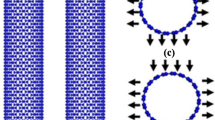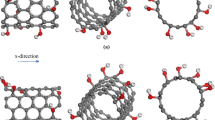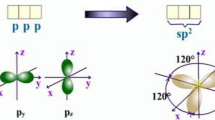Abstract
In this study, the tensile properties and fracture analysis of functionalized carbon nanotubes (CNTs) with carbene are investigated employing the molecular dynamics simulations. Tensile parameters, i.e., Young’s modulus, ultimate stress, failure strain, and fracture progress, are determined, and the effects of different attachment types, distribution patterns, the weight percentage of functional groups as well as the presence of defect with various defect weights on the aforementioned values are explored. According to the results, the tensile parameters are highly sensitive to the attachment type of carbene. In general, functionalization reduces the value of tensile parameters, especially when the attachment of carbene to base CNT is perpendicular to the loading direction. Compared to the ultimate stress and the failure strain, Young’s modulus is shown to be less affected by functionalization. It is demonstrated that the presence of defect, regardless of functionalization type and distribution pattern, reduces the tensile parameters. This reduction is more pronounced in the case of ultimate stress. Moreover, it is found that the toughness of CNTs reduces by functionalization and the presence of defects. Finally, it is demonstrated that functionalization with carbene and the presence of defects does not have a noticeable effect on the fracture progress of CNTs.













Similar content being viewed by others
References
Bachtold A, Hadley P, Nakanishi T, Dekker C (2001) Logic circuits with carbon nanotube transistors. Science 294(5545):1317–1320
Ajori S, Ansari R, Sadeghi F (2018) Molecular dynamics study of gigahertz nanomechanical oscillators based on an ion inside a series of electrically charged carbon nanotubes. Eur J Mech A/Solids 69:45–54
Baughman RH, Cui C, Zakhidov AA, Iqbal Z, Barisci JN, Spinks GM et al (1999) Carbon nanotube actuators. Science 284(5418):1340–1344
Xie XL, Mai YW, Zhou XP (2005) Dispersion and alignment of carbon nanotubes in polymer matrix: a review. Mater Sci Eng R Rep 49(4):89–112
Andrews R, Weisenberger MC (2004) Carbon nanotube polymer composites. Curr Opin Solid State Mater Sci 8(1):31–37
Sadeghi F, Ajori S, Ansari R (2020) Continuum modeling of ion-selective membranes constructed from functionalized carbon nanotubes. Eur Phys J Plus 135(7):553
Jha R, Singh A, Sharma PK, Fuloria NK (2020) Smart carbon nanotubes for drug delivery system: a comprehensive study. J Drug Deliv Sci Technol 58:101811
Ajori S, Ansari R, Darvizeh M (2015) Vibration characteristics of single-and double-walled carbon nanotubes functionalized with amide and amine groups. Physica B 462:8–14
Striolo A, Chialvo AA, Gubbins KE, Cummings PT (2005) Water in carbon nanotubes: adsorption isotherms and thermodynamic properties from molecular simulation. J Chem Phys 122(23):234712
Dyke CA, Tour JM (2004) Overcoming the insolubility of carbon nanotubes through high degrees of sidewall functionalization. Chem A Eur J 10(4):812–817
Georgakilas V, Voulgaris D, Vazquez E, Prato M, Guldi DM, Kukovecz A, Kuzmany H (2002) Purification of HiPCO carbon nanotubes via organic functionalization. J Am Chem Soc 124(48):14318–14319
Gogotsi Y, Libera JA, Güvenç-Yazicioglu A, Megaridis CM (2001) In situ multiphase fluid experiments in hydrothermal carbon nanotubes. Appl Phys Lett 79(7):1021–1023
Bahr JL, Mickelson ET, Bronikowski MJ, Smalley RE, Tour JM (2001) Dissolution of small diameter single-wall carbon nanotubes in organic solvents? Chem Commun 2:193–194
Ajori S, Ansari R, Haghighi S (2019) Small strain effect on the mechanical vibration behavior of cross-linked functionalized carbon nanotubes with polyethylene: a molecular-dynamics study. EPL (Europhys Lett) 125(4):43001
Wang HJ, Xi XK, Kleinhammes A, Wu Y (2008) Temperature-induced hydrophobic–hydrophilic transition observed by water adsorption. Science 322(5898):80–83
Ansari R, Ajori S, Ameri A (2014) Elastic and structural properties and buckling behavior of single-walled carbon nanotubes under chemical adsorption of atomic oxygen and hydroxyl. Chem Phys Lett 616:120–125
Anzar N, Hasan R, Tyagi M, Yadav N, Narang J (2020) Carbon nanotube—a review on synthesis, properties and plethora of applications in the field of biomedical science. Sens Int 1:100003
Polizu S, Savadogo O, Poulin P, Yahia LH (2006) Applications of carbon nanotubes-based biomaterials in biomedical nanotechnology. J Nanosci Nanotechnol 6(7):1883–1904
He H, Pham-Huy LA, Dramou P, Xiao D, Zuo P, Pham-Huy C (2013) Carbon nanotubes: applications in pharmacy and medicine. BioMed Res Int 2013:578290. https://doi.org/10.1155/2013/578290
Singleton JW, Misak HE, Mall S (2017) Relationships between tensile behavior, physical parameters and manufacturing parameters of carbon nanotube sheet. Mater Des 116:199–206
Georgakilas V, Kordatos K, Prato M, Guldi DM, Holzinger M, Hirsch A (2002) Organic functionalization of carbon nanotubes. J Am Chem Soc 124(5):760–761
Yang W, Thordarson P, Gooding JJ, Ringer SP, Braet F (2007) Carbon nanotubes for biological and biomedical applications. Nanotechnology 18(41):412001
Lacerda L, Bianco A, Prato M, Kostarelos K (2006) Carbon nanotubes as nanomedicines: from toxicology to pharmacology. Adv Drug Deliv Rev 58(14):1460–1470
Figarol A, Pourchez J, Boudard D, Forest V, Tulliani JM, Lecompte JP et al (2014) Biological response to purification and acid functionalization of carbon nanotubes. J Nanopart Res 16(7):2507
Druchok M, Lukšič M (2019) Carboxylated carbon nanotubes can serve as pathways for molecules in sandwich-like two-phase organic-water systems. J Mol Liq 291:111287
Wolski P, Nieszporek K, Panczyk T (2017) Pegylated and folic acid functionalized carbon nanotubes as pH controlled carriers of doxorubicin. Molecular dynamics analysis of the stability and drug release mechanism. Phys Chem Chem Phys 19(13):9300–9312
Bachilo SM, Strano MS, Kittrell C, Hauge RH, Smalley RE, Weisman RB (2002) Structure-assigned optical spectra of single-walled carbon nanotubes. Science 298(5602):2361–2366
Janas D, Czechowski N, Krajnik B, Mackowski S, Koziol KK (2013) Electroluminescence from carbon nanotube films resistively heated in air. Appl Phys Lett 102(18):181104
Yu MF, Lourie O, Dyer MJ, Moloni K, Kelly TF, Ruoff RS (2000) Strength and breaking mechanism of multiwalled carbon nanotubes under tensile load. Science 287(5453):637–640
Haghighi S, Ansari R, Ajori S (2020) A molecular dynamics study on the interfacial properties of carbene-functionalized graphene/polymer nanocomposites. Int J Mech Mater Des 16:387–400
Stando G, Łukawski D, Lisiecki F, Janas D (2019) Intrinsic hydrophilic character of carbon nanotube networks. Appl Surf Sci 463:227–233
Boroushak SH, Ajori S, Ansari R (2019) Characterization of the structural instability of BxCyNz heteronanotubes via molecular dynamics simulations. Mater Res Express 6(10):105096
Boroushak SH, Ansari R, Ajori S (2018) Molecular dynamics simulations of the thermal conductivity of cross-linked functionalized single-and double-walled carbon nanotubes with polyethylene chains. Diam Relat Mater 86:173–178
Pashmforoush F, Ajori S (2020) The adsorption characteristics and thermo-mechanical properties of BxCyNz heteronanotubes under physical adsorption of Ni(II)-tetramethyldibenzotetraaza[14]annulene (NiTMTAA): insight from molecular dynamics approach. Comput Mater Sci 176:109554
Ajori S, Parsapour H, Ansari R (2020) A comprehensive analysis of the mechanical properties and fracture analysis of metallic glass nanocomposites reinforced by carbon nanotubes and Cu nanowires: a molecular dynamics study. Mech Adv Mater Struct. https://doi.org/10.1080/15376494.2020.1746447
Ajori S, Parsapour H, Ansari R (2020) A molecular dynamics study on the buckling behavior of single-walled carbon nanotubes filled with gold nanowires. J Mol Model 26(8):1–8
Parsapour H, Ajori S, Ansari R, Haghighi S (2019) Tensile characteristics of single-walled carbon nanotubes endohedrally decorated with gold nanowires: a molecular dynamics study. Diam Relat Mater 92:117–129
Liu C, Zhang Q, Stellacci F, Marzari N, Zheng L, Zhan Z (2011) Carbene-functionalized single-walled carbon nanotubes and their electrical properties. Small 7(9):1257–1263
Chu YY, Su MD (2004) Theoretical study of addition reactions of carbene, silylene, and germylene to carbon nanotubes. Chem Phys Lett 394(4–6):231–237
Beazley DM, Lomdahl PS, Grønbech-Jensen N, Giles R, Tamayo P (1995) Parallel algorithms for short-range molecular dynamics. In: Annual reviews of computational physics III, pp 119–175
Stuart SJ, Tutein AB, Harrison JA (2000) A reactive potential for hydrocarbons with intermolecular interactions. J Chem Phys 112(14):6472–6486
Brenner DW, Shenderova OA, Harrison JA, Stuart SJ, Ni B, Sinnott SB (2002) A second-generation reactive empirical bond order (REBO) potential energy expression for hydrocarbons. J Phys Condens Matter 14(4):783
Li X, Wang A, Lee KR (2018) Comparison of empirical potentials for calculating structural properties of amorphous carbon films by molecular dynamics simulation. Comput Mater Sci 151:246–254
Zhou LG, Shi SQ (2002) Molecular dynamic simulations on tensile mechanical properties of single-walled carbon nanotubes with and without hydrogen storage. Comput Mater Sci 23(1–4):166–174
Mylvaganam K, Zhang LC (2004) Important issues in a molecular dynamics simulation for characterizing the mechanical properties of carbon nanotubes. Carbon 42(10):2025–2032
Hoover WG (1985) Canonical dynamics: equilibrium phase-space distributions. Phys Rev A 31(3):1695
Author information
Authors and Affiliations
Corresponding authors
Additional information
Technical Editor: João Marciano Laredo dos Reis.
Publisher's Note
Springer Nature remains neutral with regard to jurisdictional claims in published maps and institutional affiliations.
Rights and permissions
About this article
Cite this article
Ajori, S., Boroushak, S.H. & Ansari, R. Fracture analysis and tensile properties of perfect and defective carbon nanotubes functionalized with carbene using molecular dynamics simulations. J Braz. Soc. Mech. Sci. Eng. 42, 450 (2020). https://doi.org/10.1007/s40430-020-02530-z
Received:
Accepted:
Published:
DOI: https://doi.org/10.1007/s40430-020-02530-z




